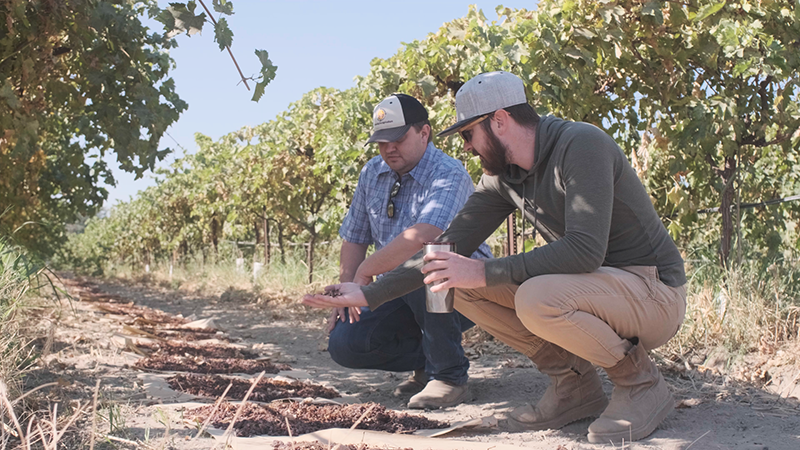Regenerative agriculture pioneer shares his thoughts on building plant immunity and why regenerative agriculture should be about much more than soil health
John Kempf is the founder of Advancing Eco Agriculture (AEA), a farm consultancy and nutritional products company that works with farmers to develop large-scale, regenerative farming systems. The company’s products include biologicals and nutritionals, microbial and fungal inoculants, and liquid macronutrients and micronutrients to boost plant health. AEA offers customized farm programs, full consultations, and plant testing to help farmers succeed. AEA’s regenerative agriculture systems balance microbial, mineral, and mechanical inputs to consistently improve farm profitability by increasing fruit size, quality, and overall yield.
Since its founding in 2006, AEA has worked with more than 10,000 farms nationwide—conventional and organic—helping farmers transition to regenerative farming practices that build soil health, plant immunity, and nutrient dense foods. The company is growing fast with sales increasing by 35% from 2021 and 2022 and the number of employees growing to 77, a 40% increase in the past year. AEA also recently announced the opening of a new 55,000-square foot manufacturing facility in Aurora, Colorado.
What led you to start Advancing Eco Agriculture?
John Kempf : I grew up on a family fruit and vegetable farm. My father was a regional distributor for seeds, fertilizers, pesticides, and equipment for fruit and vegetable growers.
In 2004, I had an awakening experience. We started renting a field from a neighboring farm that borders one of our fields. At harvest time, on the field that we had been farming for the previous decade with intense pesticide applications, 80% of the leaves were infected with powdery mildew. On the rented field that had been farmed without the pesticide applications, there was no powdery mildew.
I wanted to understand plant immunity and what allows one plant to be resistant to powdery mildew when the next plant two feet away is susceptible. What I learned is that all plants have an immune system, much like ours. Also like ours, they need to be supported with good nutrition and a functional microbiome. This was a completely new concept for us because in mainstream agronomy there is no mention of plant immune systems.
I realized that when you have healthy plants that have functional immune systems, they transfer that immunity to the people who consume them as food. Agriculture should be a public health service to improve our health because the quality of the food produced has the capacity to prevent diseases and illnesses, which doctors and hospitals in our current medical system cannot do.
This model of agronomy has the potential to produce disease- and insect-resistant and high-yielding crops, regenerate soil and public health, and reverse climate and ecological degradation. This is an obvious solution to many of our world’s challenges, and I became inspired by the potential that this regenerative model of agriculture has and led me to start Advancing Eco Agriculture in 2006.
Tell me more about plant immunity.
John Kempf: Plant immune function rests on two foundations: nutritional integrity and microbiome integrity. When you have those two in place, it is possible for a plant to be 100% resistant to all known diseases and insects. That is a very significant claim to make. But it’s one that I am confident making because we have done this successfully in the field for the last decade and a half.
Once you have plants that produce these robust immune responses and actively resist disease and insect pressure, their active immune system produces this broad range of compounds that we generically refer to as plant secondary metabolites, phenolics, and aromatic compounds. Two of these that you might be familiar with are anthocyanins in blueberries and lycopene in tomatoes.
When plants have functional immunity, they produce much higher concentrations of those compounds. In turn, consuming those plants improves our own immune system and enhances our own immune function.
What is the mission of Advancing Eco Agriculture?
John Kempf: To have regenerative agriculture become the standard globally by 2040. I’d like to see 80% of all agricultural lands worldwide adopt these regenerative models of agronomy over the next 17 years. That’s a very achievable goal, and we are well on the pathway to achieving it.
The purpose of Advancing Eco Agriculture is to show what is possible, and to set such a high standard of excellence that other companies in the agronomy space will be forced to change the way they do business as a result of our presence in the marketplace. Together we can change agronomy and agribusiness around the world.
How would you define regenerative agriculture?
John Kempf: There’s no generally agreed upon definition of regenerative agriculture. However, I believe the narrative around regenerative agriculture is being too narrowly defined in terms of improving soil health. To me, that really misses the vision of what regenerative agriculture is capable of. Regenerative agriculture needs to include regenerating public health by producing high-quality food that can enhance people’s immune systems. It needs to include restoring landscapes and regenerating whole ecosystems. It needs to include regenerating farm economics, having farms be economically viable enterprises. The most important piece is that regenerative agriculture needs to regenerate the capacity for stewardship. If we want to regenerate landscapes, that requires the presence of loving, caring hearts and hands on the landscape. Simply put, we need more people in rural landscapes, not fewer; particularly, we need more people who care. And we need to compensate them well, and right now agriculture struggles to compensate people well.
We don’t need regenerative certified farms; we need regenerative verified supply chains. As a component of the regenerative supply chains, we need to ensure that an adequate proportion of the money that’s spent on food goes back into revitalizing rural economies and regenerating the capacity for stewardship. That’s what regenerative agriculture should be all about, not about regenerating soil health exclusively.
Can regenerative agriculture produce more nutrient dense foods?
John Kempf: Yes, definitely. However, nutrient density needs to be measured and quantified much better. There is a lot more research that needs to be done in the nutrient density space. Nutrient density can now be measured in a laboratory for a few hundred dollars per sample. But in the next three to four years, that cost will come down to a few dollars per sample to measure tens of thousands of different compounds.
Just looking at mineral density, there are a few surprising observations. There are some non-organic, conventional farmers who are producing crops with very good mineral density because they are paying close attention to trace minerals and are supplying those minerals very effectively. This is particularly true for the higher value fruit and vegetable crops.
Whereas organic growers of those same types of crops, say if you were to buy broccoli from California, there’s a reasonably good chance that the broccoli that is conventionally grown has better mineral content than the organic crop, because with the organic crop, farmers are using chicken manure and liquid fish, and completely ignoring trace minerals.
I suspect that there will be many organically certified farmers who will be caught by surprise once the technology develops to begin measuring nutrient density. Though I also suspect some organic crops will be found to be at the highest levels of mineral density because those organic farmers are using cover crops, building organic matter, and regenerating their soil’s health. But some organic farmers are not doing those things.
What are your thoughts about organic farming?
John Kempf: From a philosophical perspective, I think organic farming as it exists today misses the mark of the original pioneers. Organic certification is what I term a negative process certification. It’s a list of thou shall nots, a process certification that just certifies that a certain process has been followed. It does nothing to certify the quality of the end-product.
I am optimistic that agriculture of the future will take more a positive outcomes approach rather than a negative process approach. A positive approach includes all the things that you need to address: your soil and crops’ nutritional and microbiome integrity. My vision for the future is an agriculture that is outcomes oriented to produce a high-quality product, high-quality outcomes, and to make sure that we do the things necessary to achieve those outcomes
What about increasing plant and crop yields using regenerative agriculture?
John Kempf: There is this narrative that when you transition from contemporary agriculture to organic or regenerative, you should expect to see an initial yield loss and perhaps even a continuing yield reduction for the long-term. That is a fallacy of bad agronomy.
If you have good agronomic management, you should see a yield gain. We expect to see yield gains on the farms that we work with for the simple reason that when you improve plant health and you have a robust immune system, you can’t help but to increase yields. Healthier plants just simply perform better.
Have you seen the conventional farmers you work with reduce their use of synthetic inputs such as pesticides or fertilizers?
John Kempf: Dramatically. It’s very common for us when we start working with a farm that sometimes as rapidly as a single year, sometimes two or three years, they will reduce their pesticide use by 70% to 80%, sometimes entirely. They will reduce their fertilizer use by 60% to 70% or sometimes more.
A farmer will tell us: “I don’t have diseases anymore. I don’t have insects anymore. I’m not using very much fertilizer anymore. If I wanted to, I could be organic.”
Many self-described regenerative farmers kill cover crops with glyphosate, saying that it is better for the soil than tillage. Can a farm be regenerative using glyphosate to terminate cover crops?
John Kempf: It’s challenging to reduce this conversation to only two options that the choice must either be A or B. There’s this dogmatic debate about tillage versus no-till. Some suggest that you should never till. For some soils that’s probably true but in other soils and contexts, tillage can be a very valuable reset tool to facilitate developing a disease suppressive microbiome.
It’s seldom useful to have these dogmatic debates because when we’re working with living systems, there’s always a spectrum. Are you using Roundup five times a year on an orchard floor to maintain clean rows underneath the trees or using it once every five years?
There is a rapidly developing next generation of organic herbicides that is going to be released on the market in the next year or two. I am optimistic that we will soon not need to have a conversation about killing cover crops with glyphosate or doing tillage because we will have other spray-on materials that will effectively terminate a cover crop without damaging the soil microbiome.

What is your vision for the future of agriculture?
John Kempf: When I look at how we can achieve our goal of having 80% adoption of regenerative agriculture globally by 2040, what does the pathway look like? It looks as if we are well on the path to achieving that outcome. We’re shifting now from the innovators to the early adopters. Many people who have transitioned to regenerative agriculture over the last 10, 15, 20 years, the innovators, did so as a result of duress, either financial duress or family health. We are now in the early stages of shifting from those innovators to the early adopters where people are observing the success of the innovators, and are implementing their successful practices on their own farms. As this momentum continues, I expect we will be rapidly working with the majority of farms. I believe that shift is happening right now; we’re shifting the early adopters, and that in another five to seven years or less will be shifting from the early adopters to the majority of farmers.









